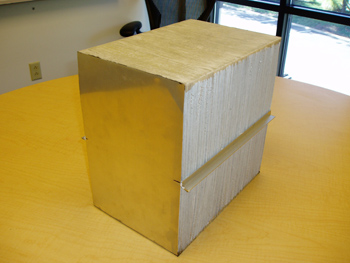 Lancaster-based Energy Wall plans to put fresher, cleaner, and less costly air into a lot of residential and commercial buildings. Its means of delivery is a unique passive, ceramic-fiber ventilator–boxed in a one-cubic-foot block–that eliminates the need for the motorized, inefficient, and leaky air-drying wheels at the heart of most heating, ventilation, and air-conditioning systems.
Lancaster-based Energy Wall plans to put fresher, cleaner, and less costly air into a lot of residential and commercial buildings. Its means of delivery is a unique passive, ceramic-fiber ventilator–boxed in a one-cubic-foot block–that eliminates the need for the motorized, inefficient, and leaky air-drying wheels at the heart of most heating, ventilation, and air-conditioning systems.
Dustin Eplee, the architectural engineer in the two-person enterprise co-invented the Energy Wall as a commercial alternative to existing ventilator systems with Ken Butcher, a ceramics engineer (and a lot of great help from other people).
The way ventilation is done now, he says, you consume energy to save energy, and that doesnt make sense.
Energy Wall design reduces the need for space for chillers and
drops the overall cost of maintenance and energy for an HVAC system. Replacing typical motor-driven ventilators, the selectively permeable membrane at the heart of the Energy Wall system allows the convection of heat between separated streams of inbound and outbound air. It also transfers water molecules, which precondition fresh air coming into the building. The membrane likewise stops the contamination of the fresh air stream by particulates and gases, including oxygen, nitrogen, and carbon dioxide from the stale air being exhausted from the system–a major problem in standard HVAC mechanics. The ceramic-fiber membrane also may kill 98 percent of bacteria coming into contact with it–an effect that Penn State engineers will soon analyze by controlled tests.
Taking the first step to commercialization, the company has installed beta test units at the offices of Burt, Hill, the international architectural firm, in Ahmedabad, India, and Dubai, as well as on the Penn State campus and in a private home in Carlisle and another in Alexandria, VA, whose owner is seeking LEED Platinum certification.
Eplee identifies a U.S. energy recovery market for commercial and residential buildings of $220 million. He says that the company would seek to capture about 18 percent of the market, or $40 million, in sales. He admits, though, that Energy Walls marketing strategy needs first of all a strategic sales manager, which he is now seeking to hire, along with factory workers to assemble the 1,000 units planned for production this year and meet a far more modest initial sales goal of $200,000.
“We’ve been totally focused on the technology and only started the work of commercialization,” he says.
Ben Franklin Partners of Central and Northern Pennsylvania have encouraged the technology’s development with no-risk loans totaling more than $200,000, including an award announced last week of $75,000. The Pittsburgh-based Green Building Alliance has granted $100,000 for test installations and commercialization.
Source: Energy Wall, Dustin Eplee
Writer: Joseph Plummer
To receive Keystone Edge free every week, click here.